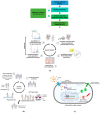Exploring the Potential of Bioactive Peptides: From Natural Sources to Therapeutics
- PMID: 38338676
- PMCID: PMC10855437
- DOI: 10.3390/ijms25031391
Exploring the Potential of Bioactive Peptides: From Natural Sources to Therapeutics
Abstract
Bioactive peptides, specific protein fragments with positive health effects, are gaining traction in drug development for advantages like enhanced penetration, low toxicity, and rapid clearance. This comprehensive review navigates the intricate landscape of peptide science, covering discovery to functional characterization. Beginning with a peptidomic exploration of natural sources, the review emphasizes the search for novel peptides. Extraction approaches, including enzymatic hydrolysis, microbial fermentation, and specialized methods for disulfide-linked peptides, are extensively covered. Mass spectrometric analysis techniques for data acquisition and identification, such as liquid chromatography, capillary electrophoresis, untargeted peptide analysis, and bioinformatics, are thoroughly outlined. The exploration of peptide bioactivity incorporates various methodologies, from in vitro assays to in silico techniques, including advanced approaches like phage display and cell-based assays. The review also discusses the structure-activity relationship in the context of antimicrobial peptides (AMPs), ACE-inhibitory peptides (ACEs), and antioxidative peptides (AOPs). Concluding with key findings and future research directions, this interdisciplinary review serves as a comprehensive reference, offering a holistic understanding of peptides and their potential therapeutic applications.
Keywords: bioactivity assays; mass spectrometry; peptidomics; structure–activity relationship; therapeutic peptides.
Conflict of interest statement
The authors declare no conflict of interest.
Figures



References
-
- Preet P. Peptides: A new therapeutic approach. Int. J. Curr. Pharm. Res. 2018;10:29–34. doi: 10.22159/ijcpr.2018v10i2.25887. - DOI
-
- Uhlig T., Kyprianou T., Martinelli F.G., Oppici C.A., Heiligers D., Hills D., Calvo X.R., Verhaert P. The emergence of peptides in the pharmaceutical business: From exploration to exploitation. EuPA Open Proteom. 2014;4:58–69. doi: 10.1016/j.euprot.2014.05.003. - DOI
Publication types
MeSH terms
Substances
Grants and funding
LinkOut - more resources
Full Text Sources
Miscellaneous

